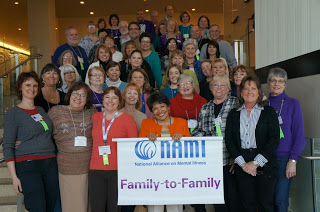March 21, 2014
Over the years I have met many families who have shared with me what NAMI Family-to-Family has done for them. They have told me how much they learned, how they have been supported, and often, how much it helped their family member. I have also been told that Family-to-Family saved their lives.
When people have taken the Family-to-Family course, they know it makes a difference for them. In a world that demands outcomes, however, it is also important to show this result is due to the course, and not due to chance or the passage of time. Thankfully a team of NAMI Maryland chapters and University of Maryland researchers led by Dr. Lisa Dixon have done just that.
First a quick review is in order. NAMI’s Dr. Joyce Burland developed Family-to-Family in 1991. It is a 12-week course taught by trained families of individuals living with a serious mental illness for other family members. The model emphasizes education, support, self-care and problem solving. It is has been used widely across the country, with over 300,000 people having taken the course, and 3,500 individuals having been certified as trainers. Family-to-Family has been translated into many languages, and has been culturally adapted and used successfully for Spanish communities in America and in Mexico and Puerto Rico (called NAMI de Familia de Familia). Today, Family-to-Family is the largest family psychoeducation program in the U.S.
Several initial papers in the decade beginning in 2000 suggested that Family-to-Family had discernable effects for the people in the course. In 2011, the first randomized controlled trial (RCT) was published of Family-to-Family, comparing the experience of people enrolled in the course and people on the waiting list as controls (they later took the course). In the Family-to-Family study, 318 individuals were assessed over a three month period on areas of coping, empowerment, and other areas of experience. The design of this study is important to understand.
The RCT is a gold standard of methodology which is designed to improve the certainty of the findings. The idea of this kind of study is to randomize a group of people eligible for the active or study arm or a control group and to follow them over time to see if the results can be attributed to the active group. The individuals doing the assessment of the impact of the course did not know if they are in the active or control group. Also, an assessment of the fidelity of the model was integrated into the study. This helps to ensure that people are getting the model when they are in the active arm of the study.
The landmark study found that the individuals in the active group of the study showed improved abilities to cope and feelings of empowerment. The control group did not show these results. The study results did not show a decrease in subjective burden of illness—the family members knew they still faced a challenge. Results on problem solving and reduction of distress were positive but not definitively so. Further studies would help to see if that finding is a real outcome of the model.
This study led to a remarkable moment in NAMI history. The National Registry of Evidence Based Practice (NREPP) listed Family-to-Family as an evidence based practice. This is a core achievement for the course. Research based evidence meets individuals experience in this certification.
A follow up study showed that the positive results stay with people who took the course. In 2013, Lucksted and colleagues followed up with the same population data set that interviewed individuals at different times. They concluded that “all benefits of Family-to-Family were sustained at nine months” including reduced anxiety improved problem solving, improved coping and knowledge. They also noted that increased attendance led to better outcomes.
Family-to-Family has been a great addition to the world of mental health services. Families often report they experience feeling left out of care, or that communication is inadequate from mental health professionals. These studies demonstrate the impact that Family-to-Family can have to improve how the family copes and functions. Policy makers and professionals have begun to take notice. Looking at how the course impacts the individuals who live with serious mental illness and how to use this program in the digital age are important areas of future research.
If you love someone in your family who is living with schizophrenia, bipolar disorder, depression or obsessive compulsive disorder (or related disorders) consider taking this important and scientifically validated course. Contact your NAMI Affiliate to find out where it is being given. It’s free, and thanks to these studies, we know it works.
We’re always accepting submissions to the NAMI Blog! We feature the latest research, stories of recovery, ways to end stigma and strategies for living well with mental illness. Most importantly: We feature your voices.
LEARN MORENAMI HelpLine is available M-F, 10 a.m. – 10 p.m. ET. Call 800-950-6264,
text “NAMI” to 62640, or email. In a crisis, call or text 988 (24/7).